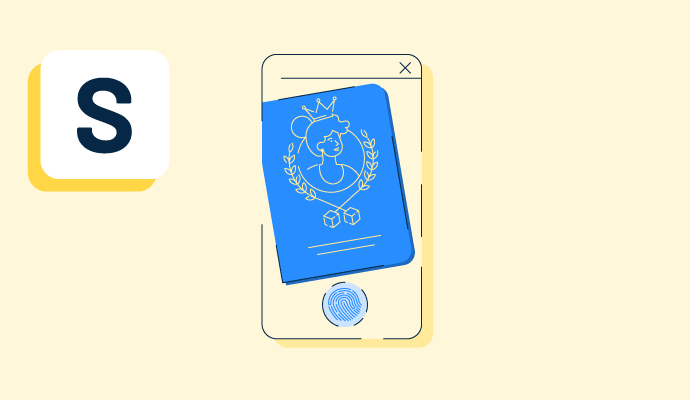What is self-sovereign identity (SSI)?
Self-sovereign identity (SSI) is a concept in which an individual has control over their digital identity. Unlike traditional models which rely on centralized credential management, SSI operates through decentralized systems, such as blockchain. This transfers the control of credentials back to the individuals, giving them more agency.
For example, SSI allows people to directly manage who has access to their personally identifiable information (PII) and sensitive credentials and for how long.
While SSI is a concept, decentralized identity solutions are the tangible products used to make it a reality. These new, typically Web3-powered technologies have applications across various industries where individuals would need to verify their identity or provide sensitive information, including higher education, healthcare, financial services, retail, and more.
Types of self-sovereign identity
Three main types of SSI concepts are used, including:
- Claim: This type of SSI concept involves an assertion of identity made by the end user, who, in this case, is the owner of the credential. Examples of claims include an end user’s address, which a third party like a post office can verify through a digital signature on a credential that other institutions, like banks, will accept.
By simply presenting verified information, the end user can make legitimate claims about their identity in a simple process of assertion. These are different from government-issued documents, as they are often made by the users or non-governmental third parties themselves.
- Proof: Proof in SSI refers to a form, document, letter, or credential that acts as evidence for a particular claim. Most users are familiar with this form of credential in everyday life, such as birth certificates, passports, government-issued IDs, and the like.
- Attestation: An attestation involves confirmation from the party being presented with the credential that the end-user is making a valid statement about their identity. Attestations are also known as validations.
Benefits of self-sovereign identity
There are a myriad of benefits to implementing SSI, with chief among them being:
- Privacy: Choosing who has access to their data gives end users a greater degree of privacy. Unlike traditional, centralized identity management systems, end users no longer need to accept that anyone with access to the centralized system could potentially access their PII or other sensitive information and credentials.
- Control: By decentralizing the storage of identity-related information, individuals have a significantly increased ability to control what parties are privy to their PII, credentials, certifications, IDs, and other personal information.
- Security: By relying on blockchain technology, SSI is, in practice, a significantly secure way to protect credentials from being tampered with. Blockchain’s unique structure of recording transactions through its ledger makes credential-sharing secure, safe, and transparent.
- Resiliency: By design, SSI decentralizes identity management, making solutions that facilitate the process immune to problems that commonly affect centralized systems. This includes malicious network penetration, data leaks, and service disruptions.
Basic elements of self-sovereign identity
SSI is comprised of several basic elements, which include:
- Blockchain: SSI is typically achieved through blockchain technology that facilitates the decentralization of a person’s identity, enabling them to have full autonomy over it. Blockchain serves as a more transparent, tamper-proof method for implementing SSI in practice.
- Digital wallets: A digital wallet is where individuals store their verifiable credentials when they have sovereignty over their identity. These wallets enable end users to securely store their credentials in a single place outside a centralized digital architecture.
- Verifiable credentials (VCs): These are documents, certificates, licenses, etc., that prove specific characteristics or attributes about the person presenting them. They are cryptographically signed by the issuer, such as a hospital, university, or government agency, to ensure the credential’s authenticity.
Self-sovereign identity best practices
Follow these best practices to implement SSI effectively:
- Educate end users: As SSI is a departure from traditional, centralized methods of credential storage, it is important to educate the end users about an SSI architecture implementation plan. This includes explaining how it works, what benefits they will receive, and how they can best use this new sovereignty over their digital identities. A better understanding of the concept will help ensure higher rates of adoption.
- Deploy incrementally: If SSI is being instituted across a large organization, such as a corporation or university, incremental deployment can help address initial bugs, errors, and adoption issues at a smaller and more manageable scale.
For example, instead of implementing SSI via a decentralized identity solution across an entire university, which would include students, faculty, administrators, university hospital staff, university museum staff, etc., the practice could first be limited to the library system. After receiving initial feedback, SSI could then be extended to the hospital, with the process repeated and eventually being rolled out across the entire institution.
- Check compliance: When implementing any new security measure, it is imperative that organizations of all sizes and across all industries remain compliant with relevant laws, regulations, and standards at all times to avoid legal and financial repercussions. InfoSec teams should remain mindful of data privacy protection and processing regulations within their jurisdictions.
Self-sovereign identity vs. digital identity
While somewhat similar, self-sovereign identity and digital identity are closely related concepts. However, they differ in significant ways.
- Self-sovereign identity: SSI is a specific type of decentralized identity that refers to the concept of individuals having full autonomy over their digital identity. It is inherently accomplished through the decentralization of credentials and their storage in a digital wallet that end users control. SSI emphasizes the privacy of its users, the discretion they have over who has access to their information, and their ability to revoke access at any time.
- Digital identity: Digital identity is a broader term that encompasses SSI. As it has traditionally existed, digital identities are stored in centralized systems, such as employee databases and patient directories. Traditionally, end-user privacy varies depending on jurisdictional regulations and the security measures taken within centralized systems
Protect your identity! Explore these 9 tips to prevent identity theft, safeguard your personal information, and stay one step ahead of cyber threats.

 by Michael Pigott
by Michael Pigott
 by Merry Marwig, CIPP/US
by Merry Marwig, CIPP/US
 by Soundarya Jayaraman
by Soundarya Jayaraman
 by Michael Pigott
by Michael Pigott
 by Merry Marwig, CIPP/US
by Merry Marwig, CIPP/US


